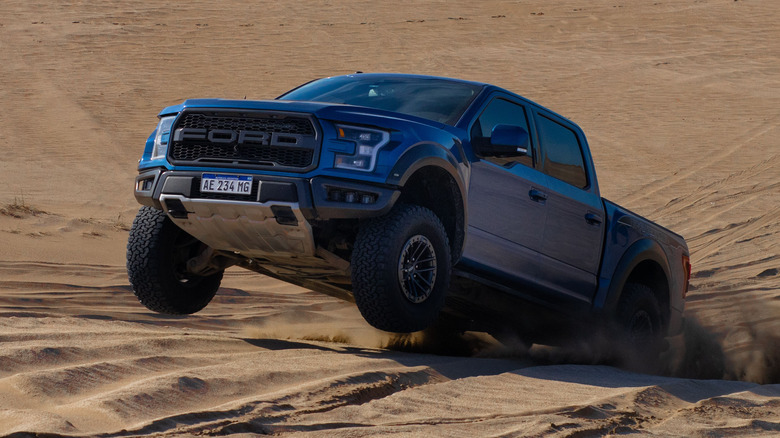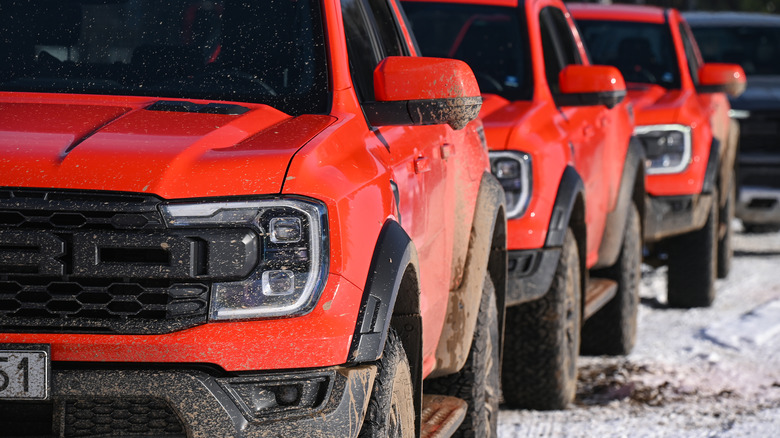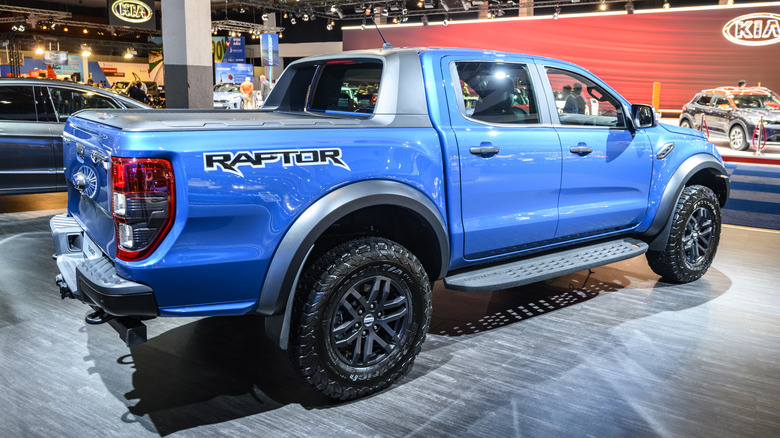Ford Ranger Raptor Vs. F-150 Raptor: How They Stack Up
Ford has been manufacturing vehicles under the "Raptor" nameplate since 2010. A name, by the way, that originated as a placeholder until the Special Vehicle Team (SVT) came up with something better. Needless to say, no other word ever conveyed precisely what the high-performance truck was all about. The Raptor moniker denotes a line of trucks that drivers can take on the road, but are powerful enough for those fun off-road excursions on the weekend.
Potential buyers looking for a Raptor are in for a treat when they see all the different options available. The Raptor line of trucks started with the F-150 — the Ranger and Bronco (not to be confused with the Everglades model) didn't join its ranks until 2019 and 2022, respectively. However, the Raptor version of the Ranger didn't debut in North America until 2023. Drivers in the United States have steadily lost favor for diesel engines over the years, prompting Ford to explore other markets with its diesel-powered midsize truck.
Now, when consumers aren't deciding between the traditional F-150 and its Raptor counterpart, they can compare the differences between the Raptor versions of the F-150 and Ranger. They might have a similar appearance inside and out, but under the hood is a different story.
The Ford underpinnings in both
Both Raptors come standard with all-wheel drive and a 10-speed SelectShift Automatic Transmission. The two trucks also sport identical safety features, such as Ford's Co-Pilot360 2.0 technology; which includes pre-collision assist, using onboard cameras and sensors to alert drivers of a potential collision. They also come with Automatic Emergency Braking (AEB), automatic high beams, a Blind Spot Information System (BLIS) with cross-traffic alert, a rearview camera, reverse brake assist, and post-collision braking.
Post-collision braking technology automatically applies brake pressure when the onboard sensors detect an initial collision. On top of all that, the Ranger model has evasive steering assist, active park assist 2.0, a forward collision warning system, intersection assist, and adaptive cruise control.
When it comes to interior features, both trucks sport a 12-inch capacitive touchscreen, compatibility with Apple CarPlay and Android Auto, seven selectable drive modes, and access to a 4G LTE wireless hotspot. These trucks are versatile machines that can race across the dunes in Glamis just as easily as they can drive along surface streets.
Key Raptor differences
While both Raptors look similar and share some features, they couldn't be more different from each other. The biggest difference is their size and power: The Ranger Raptor is a bonafide beast, with its ability to tow a maximum weight of 5,510 pounds. Meanwhile, the F-150 overshadows it with its towing capacity of 8,200 pounds. However, 5,510 pounds outclasses other midsize trucks. Chevy's ZR2, by comparison, maxes out at 5,000 pounds even.
While the Ranger comes equipped with a 3.0-liter EcoBoost V6 engine that generates 405 horsepower, the F-150 keeps a 3.5L EcoBoost High-Output V6 engine under its hood that generates 720 horsepower. The suspension is no slouch, either. The F-150 sports a 5-Link rear suspension with extra-long trailing arms, a Panhard Rod, and 24-inch coil springs to keep up with any off-road demands a driver has for it, whereas the Ranger Raptor has a Watt's link suspension at the back, along with both front and rear 2.5-inch Fox Live Valve shocks.
Ford designed the Raptors with off-roading through desert terrain in mind, but the Ranger received a little more emphasis in terms of traversing rocky trails at lower speeds. According to DrivingLine, Ford says, "The suspension upgrades in the Ranger Raptor make the most of the new FOX Live Valve dampers. The suspension adapts in real-time to enable exceptional on-road body control while absorbing corrugations and bigger ruts off-road with ease, ensuring maximum control and performance."


